August 7, 2009
Air Date: August 7, 2009
FULL SHOW
SEGMENTS
Lead in Water Underreported
View the page for this story
A Congressional investigation found twice as many Washington D.C. children had high blood lead levels during the city's water crises than the Centers for Disease Control previously reported. The data was used by the agency to reassure city residents that lead leached into drinking water wouldn't be harmful. Congressman Brad Miller speaks with host Jeff Young about the mistake and what it’s meant for cities across the country. (05:40)
A New Approach to Workplace Dangers
View the page for this story
President Obama recently announced the nomination of David Michaels to head up the Occupational Safety and Health Administration (OSHA). Michaels, a public health professional, has been an outspoken critic of polluting industries, accusing them of manufacturing uncertainty so as to undermine the science behind regulation. Host Jeff Young talks to Sidney Shapiro, a Wake Forest Law Professor and OSHA expert, about this nomination. (06:20)
Harnessing the Severn
/ Tom AllanView the page for this story
A tidal project that would put a 10-mile concrete barrier across the United Kingdom’s longest river is generating controversy. The proposed Severn barrage would help the UK produce reliable, renewable energy in its efforts to combat climate change. But critics say the huge tidal wall will harm the river ecosystem. Producer Tom Allan reports. (12:00)
Psychology of Climate Inaction
View the page for this story
Most Americans agree that climate change is important, but few see it as an urgent issue. The American Psychological Association has published a report outlining the psychological barriers to real action. They include: denial, uncertainty, lack of control and mistrust of scientists. Report co-author Robert Gifford talks with host Jeff Young about why people believe climate change doesn't require their immediate attention. (06:05)
From Mean Streets to Green Streets
View the page for this story
On the banks of Maryland’s Anacostia River sits the small town of Edmonston. This town, which is a stone’s throw away from the nation’s capital, is trying to use economic stimulus money to create a sustainable street. This “green street” will have environmentally-friendly elements like an increased tree canopy and rain gardens that will filter run-off before polluted waters enter the river. Edmonston Mayor Adam Ortiz, takes host Jeff Young on a tour of his town and talks about his plan to revamp the main street. (07:05)
Science Note/ Bees and Elephants
/ Lisa SongView the page for this story
African elephants often trample farmers’ crops in search of food, but a new fence uses beehives to deter the pachyderms. Living on Earth’s Lisa Song reports on how the elephants’ fear of bees could be the key to helping local farmers. (01:50)
Rock Snot
/ Murray CarpenterView the page for this story
Algae often prefer waters that are warm, nutrient-filled and slow moving. But the algae called didymo, also known as rock snot, thrive in cold, clear rivers. The invasive rock snot is infesting trout and salmon streams up and down the east. As producer Murray Carpenter reports, scientists are trying to understand the unusual behavior of this invader. (05:20)
Down the Hatch
View the page for this story
Mealtime for the swallow family is a dance that begins and ends at the nest. It's not a quiet affair. Salt Marsh Diary writer Mark Seth Lender has these observations. (02:50)
Show Credits and Funders
Show Transcript
Host: Jeff Young
Guests: Robert Gifford, Congressman Brad Miller, Adam Ortiz, Sidney Shapiro
Reporters: Tom Allan, Murray Carpenter
Note: Lisa Song
Commentator: Mark Seth Lender
[THEME]
YOUNG: From Public Radio International - this is Living on Earth.
[THEME]
YOUNG: I’m Jeff Young.
How the Centers for Disease Control lost control of vital data on contamination of the capital’s water. A congressional investigation says the CDC got it wrong about lead.
MILLER: Some of these kids had more than six times what is the level of concern for lead in the blood and parents in Washington thought they didn’t have to worry because they trusted the CDC.
YOUNG: Plus - a plan for a massive wall across the mouth of one of England’s most scenic rivers. It could produce tidal power, but so far it’s just generating controversy.
EVANS: If you build a barrage and you get it wrong you can't do anything about it. You have millions of tons of concrete there - short of blowing it up, you're stuck with it.
YOUNG: Those stories and more - this week on Living on Earth! So, stick around.
[THEME MUSIC]
YOUNG: From the Jennifer and Ted Stanley studios in Somerville, Massachusetts, this is Living on Earth. I’m Jeff Young.
Lead in Water Underreported

Columbia Heights, one of the Washington, D.C. neighborhoods where drinking water contained high levels of lead.
YOUNG: In the nation’s capital, a well-intentioned change to the city’s water system eight years ago accidentally tainted some residents’ water with lead. The dangerous neurotoxin leached out of old pipes over a three-year period.
The full extent of that lead exposure is just coming to light, and the findings raise questions about the behavior of one of the country’s foremost health agencies, the Centers for Disease Control. Congressional investigators now say the number of children with high levels of lead in their blood was far higher than CDC had reported.
North Carolina Democrat Brad Miller chairs the House subcommittee doing that investigation. Congressman Miller says CDC based their conclusions on incomplete data.
MILLER: It turned out that there were a whole lot of missing tests and a lot of them showed elevated blood levels in children – some to alarming levels. And it was actually well more than half – it was almost two and a half times as many elevated blood level results for children.
YOUNG: So you found 486 children with elevated lead levels in their blood?
MILLER: Right, and the CDC’s report had been 193. But more than that CDC had sponsored a published article in a learned journal that said that, “you know, funny thing – really high lead levels in the drinking water, but it’s not showing up as elevated lead levels in the blood. So there’s really not much to worry about.”
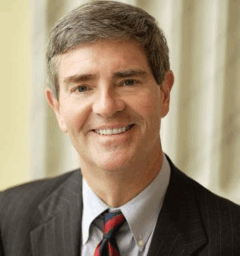
Congressman Brad Miller of North Carolina.
YOUNG: So CDC put out a paper saying; “No indication D.C. residents have blood lead levels above the CDC levels of concern.” I guess what you’re saying is they just didn’t have the data to back that up.
MILLER: No. And they knew they didn’t have the data to back that up. They knew that there was this unexplained precipitous drop in the number of blood lead level tests that had been reported to them, from 16,000 to 9,000 from 2002 to 2003. And they did not pursue the obvious question of why there were so few blood level tests for 2003 when in the previous years it had been almost twice as many tests. And they published an analysis that said, “you know, surprisingly enough there doesn’t appear to be a relationship between elevated lead in drinking water and elevated lead in blood,” when they knew that that data was wrong and they knew that that study would be picked up and widely published. And as a result of that, the pressure was off in Washington and in other parts of the country; local government that had high lead levels in their drinking water supply didn’t act to reduce it because of the CDC study.
YOUNG: So the implications here go beyond just D.C. residents not getting adequate information about the potential health risk. This goes to other cities.
MILLER: Yes, and that includes New York, and Seattle have had elevated lead levels in their drinking water more than the Safe Water Drinking Act allows, but because of the CDC study and analysis they decided it wasn’t that big a deal.
YOUNG: And that’s a reasonable reaction I think by other health officials because, hey, it’s the CDC, right?
MILLER: Sure.
YOUNG: We can trust them.
MILLER: You think the CDC is the leading authority on this kind of thing in the world.
YOUNG: Does this look to you like an honest mistake by CDC or something else going on here?
MILLER: Well we’re gonna pursue this. We’re gonna find out what happened to the missing data, because there’s like 7,000 results missing. And we’ve found a lot, but somehow thousands of results got dropped and well more than 200 elevated blood level results got dropped. And we’re gonna find out what happened to the missing data. And we’re gonna find out why the CDC didn’t pursue it when there was obviously reason to suspect that the data wasn’t right. We’re gonna continue to pursue what happened here.

Columbia Heights, one of the Washington, D.C. neighborhoods where drinking water contained high levels of lead.
YOUNG: And do you expect you will have a hearing on this?
MILLER: We will having hearings probably in September, yes, when Congress comes back into session next month. This is not the first time our subcommittee has looked at CDC. And they have had a tendency in recent years, the Bush years basically, to be nonchalant about the effect of environmental exposures on public health. And I think that CDC has world-class scientists. There are people who are devoted to the mission of CDC. But it’s pretty clear from this and from a lot of other instances that CDC really needs new leadership and a new culture. And I hope they’re getting that now.
YOUNG: What about those – we’re talking about nearly 500 children in D.C. who had high lead levels in that year that you’ve found anyway in 2003. Do we know what’s become of them?
MILLER: I don’t think so. But that would be a useful follow up—is trying to find those almost 500 kids and find out how they’re doing. And that’s of the 13,000 or so, 14,000 or so that had the blood test for lead. But presumably there were thousands and thousands more than that who were at that vulnerable age who were exposed. And I have thought about this and wondered what I would think if I were a parent in Washington during this period and I was relying upon the CDC to make sure that my child was not exposed to a public health risk because of environmental exposure. I’d be … apoplectic. Some of these kids had more than six times what is the level of concern for lead in the blood. And the result can be a permanent loss in IQ, motor coordination and ability to communicate. And parents in Washington felt they didn’t have to worry because they trusted the CDC.
YOUNG: Congressman Brad Miller chairs the House Science Subcommittee on Investigations and Oversight. Thanks very much for your time.
MILLER: Thank you.
YOUNG: We contacted the CDC – they say they haven’t seen the report from Congressman Miller.
Their statement reads in part – “CDC’s key point was that communities should be alerted when they change the chemistry in their public water systems to ensure that lead concentrations in drinking water remain below the EPA action level.”
There’s much more on our website loe.org
Related links:
- Learn more about the inquiry into CDC
- For previous LOE coverage of D.C.’s lead problems, click here.
- Congressman Brad Miller
- To read the CDC statement to Living on Earth click here
A New Approach to Workplace Dangers
YOUNG: President Obama has picked a new leader for the Occupational Safety and Health Administration, or OSHA. And the nominee, David Michaels, is sure to raise some eyebrows in the business community that OSHA regulates.
As an epidemiologist at the George Washington University School of Public Health, Mr. Michaels was a fierce advocate for worker safety and a harsh critic of industry.
Last year he told Living on Earth how polluting companies manipulate regulators behind the scenes.
MICHAELS: We need a lot more transparency, and I'm hoping that the next administration, the next president, whoever that is—guarantees that all of these decisions around how we regulate chemicals, how we measure the effects on people's health, are done in a way that's transparent.
YOUNG: If confirmed, Michaels will get a chance to do that at OSHA, an agency that’s been widely criticized. Wake Forest University law professor Sidney Shapiro is one of those critics.
In his book “Workers At Risk,” Shapiro says OSHA is in sore need of reform.
SHAPIRO: David Michaels has his job cut out for him. I think it’s fair to say that OSHA is one of the most dysfunctional agencies in Washington. For example, Congress had a plan how to regulate toxic chemicals in the workplace. And OSHA has been almost unable in the last ten years or so to fulfill that plan. In fact, it’s only issued three health regulations in roughly ten to the last fifteen years.
YOUNG: And, you know, as the name implies, there’s both safety and health in OSHA’s charge here. I guess from what you’re saying is they should be doing a better job with work place exposure to toxic substances.
SHAPIRO: Well, I think that most of us think that they need a stronger push in both directions, but if one had to pick which half of OSHA needs the most work, I think there’s almost universal consensus that we have to do something better to protect the health of workers. Science doesn’t fully understand how our exposure to chemicals day in and day out affects our body. But what we do know is if we are exposed to toxic substances in the work place or even the air – air pollution – eventually it takes a toll on our body, but that toll shows up maybe fifteen, twenty, twenty-five years later. So we have this challenge of regulate now and get the protection later, but that’s a very important challenge.
YOUNG: Now we had the opportunity to speak with David Michaels when he published his book called “Doubt is their Product.” And it had some pretty harsh criticism for industry and industry’s role in the regulatory process. Here’s how he summed things up.
MICHAELS: What polluters have seen is that the strategy that the tobacco industry came up with, which essentially is questioning the science, find the controversy and magnify that controversy, is very successful in slowing down public health protections. And so the scientists who used to work for the tobacco industry are now working for most major chemical companies. They don’t have to show a chemical exposure is safe. All they have to do is show that the other studies are in question somehow. And by raising that level of uncertainty, they throw essentially a monkey wrench into the system.
YOUNG: Now that’s a pretty strong condemnation, not just of industry’s role here but of the regulatory process itself, isn’t it?
SHAPIRO: It is, but it’s one that I think is pretty mainstream. If you talk to anyone but the regulated industry, I think most environmentalists, certainly most workers advocates would agree with David Michaels about what’s been happening.
YOUNG: What does that tell us about the kind of approach that Mr. Michaels would bring to OSHA?
SHAPIRO: Well, I think he would bring a breath of fresh air. David has a number of ideas and they follow along the lines that the people who produce the risk oughta really be responsible for understanding it and doing something about it. More profoundly, I think it’s important that we know that David Michaels is a health professional. And I think OSHA’s done best when it’s had administrators from the public health community. It is, after all, a public health agency. More times than many of us would wish, it’s been headed by someone who’s been an adamant critic of OSHA and has come from industry or been an industry lawyer.
YOUNG: Now if confirmed, Mr. Michaels as head of OSHA would work within the Department of Labor. And the Secretary of Labor, Hilda Solice also has expressed a lot of interest in strengthening the regulation particularly of workplace exposure to chemical hazards. Does this indicate that some change is coming here?
SHAPIRO: I think so. The problem that both of them face is two-fold. First, what can we do within the confines of existing legal authority? And then, secondly, can they get the administration to go to Congress and try to rectify what we now know are some of the fundamental problems with our legal approaches to environmental hazards, particularly toxic chemicals – both in the workplace and in the air.
YOUNG: What sort of barriers will he run up against?
SHAPIRO: The political barrier is OSHA’s very unpopular. It’s been unpopular for a long time. The business community has played on that lack of popularity to stymie it and cut its budget. And he’s going to have to try to convince the broader public that OSHA’s out there doing a good job.
YOUNG: Wake Forest University Law Professor Sydney Shapiro. Thanks very much for your time.
SHAPIRO: My pleasure.
Related links:
- Learn more about the recent nomination here.
- Click here for a previous LOE interview with David Michaels
[MUSIC: Steve Cropper/Felix Cavaliere “Jamaica Delight” from Nudge It Up A Notch (Concord Music Group 2008)]
YOUNG: Coming up: why some Brits say one clean power project is daft as a brush, potty, barmy - well, they just don’t think it’s very smart. Keep listening to Living on Earth.
Harnessing the Severn

The River Severn is popular among surfers like Donnie Wright. (Photo: Tom Allan)
YOUNG: It’s Living on Earth – I’m Jeff Young.
This year the European Union passed ambitious new energy standards — 20 percent of total power from renewable sources by 2020.
That’s a challenge for the United Kingdom, which is one of Europe’s worst performers on renewable energy. The UK government wants to tap into the country’s great potential for wind, wave and tidal power.
But proposals to harness the River Severn are so far generating mostly controversy. At two hundred and twenty miles, the Severn’s the UK's longest river. But what attracts clean energy engineers is the tidal action at the river’s mouth. Its estuary has the second greatest tidal range in the world.
Capturing the energy of that tidal flow could meet five percent of the entire country’s electricity needs. But, Tom Allan reports that some fear it could be disastrous for this renowned river.
[DAWN SOUNDS: BIRDS, WATER]
ALLAN: It's dawn on the banks of the River Severn in the Southwest of England. The river flows in sluggish channels past wide sand banks and shallow, muddy areas before emptying into the Bristol Channel, and then the Atlantic.
[DISTANT ROAR BEGINS TO BUILD]
ALLAN: There's a roar in the distance. Downstream, dozens of surfers and kayaks ride a wave.
This is no ordinary wave. This is the Severn bore, a tidal surge caused by the funnel shape of the Severn, and the enormous difference between its high and low tides - as much as fifty feet. The wave travels upstream, against the current.
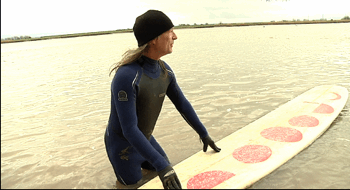
Donnie Wright gets ready to catch the wave running up the Severn. (Photo: Tom Allan)
[CRESCENDO AS THE WAVE HITS]
WRIGHT: Too much wind that one ... but can't complain. Got a nice little ride while it lasted...
ALLAN: Donnie Wright has surfed the bore for fifteen years. With his long grey hair and black wetsuit, he looks like an otter.
WRIGHT: It's the loneliness of the experience. It's just you and nature.
ALLAN: It's clear that the Severn means more to Wright than just surfing.
He leans forward earnestly as he searches for the words to describe the iconic river.
WRIGHT: The Severn is a river, which has been flowing, determined by the tide, the diurnal tide, twice a day, in and out...the bed scars, the banks get flooded, fertilized. It is a magical place.
ALLAN: For Wright, the river is almost sacred – something to be treated with respect.
But for others, the river is a potential resource to be harnessed in the fight against climate change.
The UK Government is currently considering a number of renewable energy schemes for using the Severn. One of the main proposals is a barrage across the mouth of the river - a massive wall of concrete blocks ten miles long.
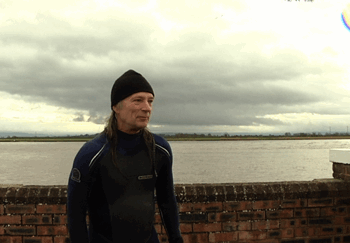
Surfer Donnie Wright. (Photo: Tom Allan)
When the tide comes in, the barrage would trap and hold the water, then release it through hundreds of turbines. Proponents say it would generate and average of 2,200 megawatts a year. That’s equal to a little more than two large power plants, and enough electricity for three million people - an enormous source of clean, predictable, renewable energy for the next century.
But to the dismay of some, it would halve the river’s tidal range, and end the run of the bore. Again, Donnie Wright.
WRIGHT: This River will just die. Put a barrage across like that, the barrage's effectiveness will not be a hundred years; it probably will only be ten years. It'll just silt the whole place up, and turn the whole place into a vast bog.
ALLAN: Critics of the barrage, point to the Bay of Fundy in Canada, the highest tidal range in the World. There, a small barrage caused both silting and coastal erosion. On the other hand, a barrage at La Rance in France has been a reliable source of energy for forty years, without silting.
Chris Morgan of the Severn Tidal Power Group, the consortium behind the UK barrage proposal, says silting shouldn't be a problem.
MORGAN: The sediment is moving continuously up and down the Severn Estuary, it's carried in on the high spring tide, and it’s carried out on the low spring tide. It's not predominantly coming down the rivers. Therefore creating a barrier across the Severn estuary is not going to make the impounded area silt up.
ALLAN: Experts at the Cardiff School of Engineering in Wales agree. Their studies show that after an initial deposit of about a foot of silt, only small amounts will be added over time.
The Severn Tidal Power Group is counting on the barrage to operate for at least a hundred years. It has to, say critics, to justify its enormous construction costs – estimated at around 30 billion U.S. dollars. The Government is looking at how best to finance the project. Whatever they decide, it's likely to be an expensive way to produce electricity.
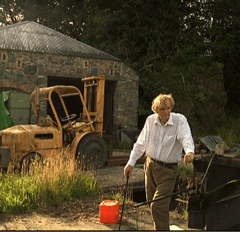
Inventor Rupert Armstrong Evans designed a low-lying tidal reef to harness the River Severn’s tide power. (Photo: Tom Allan)
But, Chris Morgan says that the barrage is an essential part of the energy mix - if the UK is going to meet its 2020 targets to combat climate change.
MORGAN: It has the possibility to produce at least five percent of the UK's electricity from an entirely renewable and carbon-free generating source. We need the electricity, we need the energy, and it needs to come from clean and renewable sources.
ALLAN: Clean energy from the tides – it's a compelling vision. But whether a Severn Barrage would provide truly green energy is debatable – because of the impact it would have on wildlife and habitats.
[SOUND OF THE ELVER FARM]
ALLAN: Surfers aren't the only creatures that hitch a lift on the river tides. Baby eels – elvers - use it, too.
[SOUND OF DOORING OPENING, WATER POOLS]
COOK: These are the elvers.
ALLAN: Horace Cook and his family have been fishing and farming elvers for decades. He holds up a handful of the tiny transparent creatures, wriggling with energy.
COOK: Marvelous animals, absolutely fascinating creature, mysterious, unbelievable. We know very little about them, let’s face it.
ALLAN: When Cook was a boy, elvers were a cheap meal, fried with bacon by the thousands. They were so abundant that they were even fed to cattle. Nowadays, a pound could cost you about 150 dollars.
Cook exports his elvers to help restock other rivers around the world. The Severn, he says, is ideal for the young eels.
COOK: The Severn has this wonderful tidal influence. We have a large tidal bore that comes up. These little animals use that energy to get up into the river.
ALLAN: Horace isn't too worried about the barrage project – he thinks his little elvers can adapt to changes to the river. But disruption to migratory passages and injury by turbines would have a major impact on these eels, as well as on salmon, and shad, according to the Sustainable Development Commission, an independent watchdog that advises the government.
And other animals that depend on the tidal cycle are certain to be affected.
[SOUND OF WATER AND MUDDY FOOTSTEPS]
ALLAN: Back on the riverbank at low tide, and the bore has washed up a thick layer of rich, slippery mud that coats everything. Downstream, birds are returning to the mudflats that had disappeared with the flood.
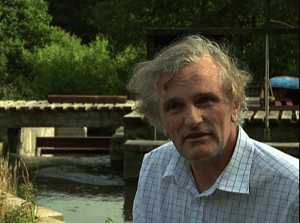
Engineer and inventor Rupert Armstrong Evans. (Photo: Tom Allan)
These intertidal mudflats are an important habitat for thousands of wading birds and waterfowl, says Richard Inger, a researcher at the Centre for Ecology and Conservation at the University of Exeter.
INGER: What might just look like a plain bit of mud to us actually is a restaurant to many bird species. If you go down below the top layer of the mud, there's hundreds and thousands of different species of worms and arthropods that use this as their home. And that's what the birds go for, you know, it's a real larder for them.
ALLAN: Inger says the barrage would permanently flood these mudflats - closing the larder door.
INGER: If a barrage is put across the whole of the Severn there will be a loss of large areas of intertidal habitat, which will undoubtedly impact a lot of the species that use these areas as feeding grounds.
But perhaps surprisingly, Richard Inger actually supports the barrage proposal.
INGER: Finding new ways of producing energy's always going to be difficult, and there are always going to be some environmental impacts. But if we think of this on a national scale, and on an international scale, the importance of reducing carbon emissions and the effects of climate change are far more important than small scale impacts at a local level.
ALLAN: A majority of the public agree. In a survey conducted by the Sustainable Development Commission in 2007, 58 percent of people were in favor of a barrage, and only 15 percent were against.
But the loss of such a unique habitat remains the major sticking point for leading environmental groups. They say that you don't have to choose between combating climate change on the one hand, and loss of precious habitats on the other. Instead, they've waded into the engineering side of the debate, backing alternatives to the barrage.
Friends of the Earth are backing an offshore lagoon design. Instead of a wall, round or oval lagoons would stand freely in the river estuary, filling up and emptying without stopping the tide.
And the Royal Society for the Protection of Birds has helped fund a tidal reef proposal by engineer and inventor Rupert Armstrong Evans.
[SOUNDS OF THE FARM, AND WATER]
ALLAN:At his ramshackle Cornish homestead Evans shows me his garden, surrounded by water mills and barns filled with hydroelectric machinery. He founded one of the countries first renewable energy companies in the 1970s. The company specializes in small-scale, hydroelectric schemes, including community projects in Brazil, Africa and India. Financing his reef proposal has meant taking out loans, and re-mortgaging some of his property - but he feels passionately that an alternative to the barrage must be found.
EVANS: If you build a barrage and you get it wrong you can't do anything about it. You have millions of tons of concrete there - short of blowing it up, you're stuck with it.
ALLAN: Mr. Evans says that his low-lying reef would generate just as much energy as the big barrage, but without the environmental impacts. By harnessing a greater volume of water, rather than creating a large height of water, it would avoid disrupting the tides as dramatically. Less of the mudflats would be submerged, and the slower turbines would kill fewer fish.
He says that a new approach to engineering is needed – one that starts with the environment, not the machinery.
EVANS: I don't think that it's a major problem to make the engineering work in a way that is sympathetic to the Severn, so that you're working alongside the natural rhythm of the tide, rather than being a monolithic structure that imposes itself on the river and can cause an environmental disaster.
ALLAN: Much to Evans' dismay, the large engineering consortium of Rolls-Royce and Atkins has just been awarded government funding for a strikingly similar scheme. The Severn Embryonic Technologies fund was recently launched, giving $800,000 to three proposals that promise to harness the Severn without having major impacts on the environment.
But, so far, the government seems to favor the more established large barrage design - despite warnings from its own Environment Agency that it should not be built because it would be ecologically damaging.
Time is running out. With the 2020 emission reductions targets looming, the pressure is on to get started on one of the projects as soon as possible.
The government has said it will make a decision next year.
Until then, the debate about how best to harness the energy of the remarkable Severn promises to be as turbulent and unpredictable as the river itself.
For Living on Earth, I’m Tom Allan in Newnham on Severn.
[WAVE CRASHES]
Related links:
- Read the report by Sustainable Development Commission.
- Severn Tidal Power Group
- Researcher Richard Inger resume
- The Severn Embryonic Technologies Scheme
- Rupert Armstrong Evans Tidal Reef Plan
- Elvers in the Severn
[MUSIC: Dean Fraser “Walk On The River” from Big Up (Island Jamaica Jazz 1996)]
Psychology of Climate Inaction

Caption: Professor Robert Gifford, University of Victoria in British Columbia. (Robert Gifford)
YOUNG: Scientists have made it clear about climate change: Warming is unequivocal, and very likely due to humanity’s actions.
But you wouldn’t know that from the debate on Capitol Hill. Consider these comments from Oklahoma Senator James Inhofe and California Congressman Dana Rohrabacher.
INHOFE: You let me just once again state my belief, that global warming is an alarmism and it's a type of a hoax.
ROHRABACHER: Wake up America, we haven’t had any global warming for ten years!
YOUNG: Now psychologists are turning their attention to the great divide between science and public opinion on climate change.
Professor Robert Gifford, at the University of Victoria in British Columbia, led a task force studying global warming attitudes for the American Psychological Association. Gifford sees a telling parallel between those who doubt climate change, and those who ignore health warnings about smoking.
GIFFORD: Early on in the smoking campaign, it was learned that people reduce what we call cognitive dissonance in one of two possible ways. You’re told that smoking is bad for you, but you’re addicted to cigarettes. You have two choices. You can either stop smoking, which is very difficult; or you can change your mind about smoking, which is easier.
So, in terms of climate change, it’s the same thing. You’re told it’s a problem, so either you can change your behavior, which, because of all these different obstacles is difficult – or you can change your mind. So, it’s fairly easy to listen to the radio commentators who tell you it’s not a problem. It’s comforting, because it’s easier to change my mind about it and become a denier than it is to actually change.
YOUNG: And I guess it doesn’t take that much injection of uncertainty or doubt around the issue to help you along that path.
GIFFORD: That’s right, because that’s the easier path, right – you know, path of least resistance and all that.
YOUNG: The denial camp isn’t really your target so much as the folks who accept that climate change is real, but have a hard time grasping why there should be a sense of urgency attached to it. Is that correct?
GIFFORD: Exactly. Very roughly if you look across different countries including the U.S. and others, figure about twenty percent of the population is what you might call a denier or hard questioner. But the other eighty percent are people who say yes, it’s really a big problem, but, but, but.
The eighty percent are willing to change, but they don’t know how, they don’t know why and they have other barriers such as the one that I call conflicting goals and aspirations, which is climate change is not the only goal that people have. They’re also worried about their health, their children’s safety. And some of these other goals trump climate change, and again it’s gonna take some time to really hit home.
YOUNG: So your report lists several reasons that might explain why people would say yeah, climate change is real, but I don’t really need to do anything about it. What are they?

Professor Robert Gifford, University of Victoria in British Columbia. (Robert Gifford)
GIFFORD: Well there’s at least a dozen reasons that I’ve identified. One is just a sense of uncertainty. There is unavoidably a little bit of uncertainty about just when and where and what is gonna happen. Second, there’s mistrust in some people of scientists and policy makers.
Next up, people sometimes think that what they do won’t have much affect. Then there’s something called optimism bias and that is as part of healthy functioning we tend to be overly optimistic about a lot of things. We think that - something like eighty five percent of people think that they’re more intelligent than average. A majority of people think they’re better looking than average. It’s psychologically healthy to be optimistic, but when you apply this to climate change, “well, don’t worry about it, mother nature will take care of it,” etc, you can see where optimism can be a bias that doesn’t work very well.
YOUNG: You also list just doing the same things we’ve always done.
GIFFORD: You know habit can be a good thing. William James, one of the fathers of modern psychology, called habit the flywheel of society. And what he meant by that was that if we didn’t have a lot of habits, society would be chaotic and we wouldn’t be able to really function as a society. But really habit can also be a negative thing. If I drove to work yesterday, I’m quite likely to drive to work today. It’s easier to do the same thing that we did yesterday as today. And maybe it’s not the best thing for the climate.
YOUNG: You know, I get the sense from some scientists that there is some frustration here. They think, hey, we’ve laid out the facts, and these are the conclusions we came to, but is just laying out the facts necessarily gonna lead someone else to the same kind of thinking?
GIFFORD: Absolutely not, and this is one of the main roles I think that psychologists can play on both sides – helping the scientists understand that laypeople don’t always understand or accept what they say instantly and on the other side, helping lay people to understand how scientists work and how they think and what they’re doing.
YOUNG: Well let’s say you’re successful in getting a person to change behavior. At some point that person might ask, “well, what good does it do if it’s just me changing my light bulbs?” There has to be some connection to a broader something going on, right?
GIFFORD: Yeah, when people feel that they’re part of a positive movement, they’re happy to join in. So you get a kind of tipping point effect at some point. It’s what everybody is doing. And people reward each other in subtle ways for sharing that goal.
YOUNG: And by the way, you do know how many psychologists it takes to change a light bulb, don’t you?
GIFFORD: [laughs] I think I’ve heard this one. [laughs]
YOUNG: Just one. But the light bulb has to want to change.
[LAUGHING]
YOUNG: Robert Gifford is a professor of psychology at the University of Victoria in British Columbia. Thanks very much for your time.
GIFFORD: You’re welcome. I enjoyed talking.
Related links:
- Professor Gifford’s Website
- APA press release on the task force report
[MUSIC: Dave Douglas “Flood Plain” from Moonshine (Koch Records 2008)]
YOUNG: Just ahead: greening the economic recovery, one town at a time. Stay with us on Living on Earth.
From Mean Streets to Green Streets

Edmonston's town square. (Courtesy of the town of Edmonston)
YOUNG: It’s Living on Earth, I’m Jeff Young.
When President Obama signed the economic recovery act six months ago he wanted to improve the environment as well as the economy. Billions of stimulus dollars poured into clean energy, mass transit and of course, the popular Cash for Clunkers program.
Most stimulus spending on transportation, however, is less environmentally friendly - old fashioned roads and highways.
But Edmonston, Maryland, a small working class town just outside of Washington, is putting recovery act money into an innovative project to green its mean streets.
Mayor Adam Ortiz says Edmonston’s main drag, Decatur Street, is noisy, hostile to pedestrians and prone to flash flooding.
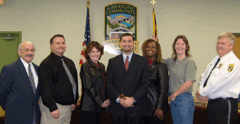
Edmonston’s mayor Adam Ortiz (center) with city officials. (Courtesy of the town of Edmonston)
ORTIZ: Our town straddles the Anacostia River, which runs through Northeast and Southeast Washington D.C., flows into the Potomac and ultimately into the Chesapeake Bay. The Anacostia is kind of the forgotten river of our region and it’s the one that’s actually closest to the people. The Potomac is a beautiful river, but it’s primarily a rural river that comes out of West Virginia and Maryland. But the Anacostia flows through communities and is truly the nation’s urban river.
YOUNG: And sounds like from time to time Edmonston gets a little too much of the Anacostia.
ORTIZ: Well it’s funny you say that. We straddle the Anacostia, and for years we’ve struggled with terrible flooding. But this is kind of the interesting part, Jeff: our flooding does not come from the river. It comes from the storm water that flows off of parking lots and roads and highways and rooftops from this region trying to get to he Anacostia River. All of our flooding is completely manmade. So that’s part of the reason that we decided to try to be more environmentally responsible in our little corner of the world here.
YOUNG: Great. Let’s take it to the streets.
ORTIZ: Alright. Sounds good.
[SOUNDS OF DOOR OPENING]
ORTIZ: Edmonston was incorporated in 1924. The reason that we were incorporated was to build a bridge across the Anacostia River. Our slogan is that “we’re a bridging community” both literally in that bridge across the river, but also that we’re a working class town where people get their start in America. Our history is just rich with working folks getting a leg up and building a better life for their children here.

Edmonston’s plan for a green main street. (Courtesy of the town of Edmonston)
[SOUND OF CICADAS]
ORTIZ: It’s a hot and humid day here in metropolitan Washington with the sounds of cicadas around us.
[SOUND OF CICADAS]
ORTIZ: Okay, right now we’re at the corner of 52nd Avenue and Decatur Street. This is right on the green street. It’s gonna look very different six months from now.
YOUNG: What’s wrong with Decatur as it is now?
ORTIZ: Well, what’s wrong with it is it’s basically just a regular old street. And in watershed areas, particularly ours here in the Chesapeake Bay, a lot of the pollution comes from storm water mismanagement. That means that when the rain falls or rain comes down on hard surfaces it washes all the pollutants off of our roads and our streets and our parking lots into the concrete storm water system underground and into our rivers.
So the street now is just a very wide asphalt boulevard. And we’re gonna transform it into a new kind of main street that’s 100 percent environmentally responsible.
YOUNG: Well, how do you do that?
ORTIZ: Ok. Well, there’s a few things we’re gonna do. And we think about it from top to bottom. From the top of the tree canopy to the very, very bottom of the storm water system underground. And I’m gonna kind of take us through layer by layer.
Now at the top we need to improve our tree canopy here. We need to have bigger trees, native growth trees to reduce the heat island effect in a lot of urban areas and also increase the amount of birds and bats that can live in this area to be natural predators for mosquitoes and other insects that are problem and nuisances here.

The town of Edmonston straddles the Anacostia River. (Courtesy of the town of Edmonston)
YOUNG: You’re hopeful that you’re gonna have people moving on two wheels instead of four more often, yeah?
ORTIZ: Yeah, that’s exactly right. We’ll be building out bike paths. And actually those bike paths will be made with a special sort of brick that engineered to absorb water. So the storm water will actually fall through the bricks into our filtration system underneath the street. So it will be bike friendly. It will be environmentally friendly and it won’t look too bad either.
[TRAFFIC SOUNDS]
YOUNG: Now I can hear a lot of traffic roaring by there. I guess the goal is you want to slow ‘em down?
ORTIZ: Yeah, we want to slow ‘em down. We’re going to prohibit big trucks from being on the street. That’s not just a safety hazard but it does beat up the street quite a bit and also makes it a little less safe and, you know, of course the emissions coming from trucks are much greater and much worse than smaller vehicles for our residents here.
So we’re going to narrow the street, which means that we’ll have more room to increase the tree boxes, which are the green areas along the side. And this kind gets to the most important feature – those green areas are going to actually be natural rain garden filtration systems. They’ll be a number of layers of different types of sedimentation and rock and gravel on the bottom for the filter and on the top native plants and trees that will absorb pollutants as well. So, the water going up through the vegetation or down through the water table will be made clean again before it goes into the river if it does at all.

Edmonston's town square. (Courtesy of the town of Edmonston)
YOUNG: So you’re gonna slow down that run-off problem.
ORTIZ: Right, exactly. So it’s gonna keep areas in our town from getting overwhelmed by the effects of flash storms, which is certainly a problem these days. But its also just gonna keep rain water where it lands for the most part. That water will hit the ground and then drip into the ground like it did a hundred years ago before this pavement was here.
YOUNG: From the treetops right down to the subsoil you’re basically rethinking how the water moves, how the traffic moves, how the people move.
ORTIZ: Yeah, that’s exactly right. I mean everything is one hundred percent interconnected. You know, the way we build our streets affects the way that we behave, the way we drive, the way we walk, the way we interact. So every piece is significant. And you know, we’re doing our best to look at it as a whole. These are the veins, the arteries of our community. You know, we want to give them the best attention that we possibly can in the most responsible way.
YOUNG: And do we have an idea of what will be the effect on the Anacostia River? It sounds to me like in addition to doing good for Edmonston you’re gonna do some good downstream.
ORTIZ: We think so. The Anacostia River is not swimable, it’s not fishable, it’s certainly not drinkable. And when this street is complete we’re gonna cut off our contribution to that problem. And we hope it will make a small difference, but we hope over time that other towns and cities will do the same and we’ll have a bigger impact.
YOUNG: Hmm. So you want other towns and not just big towns to be able to do the same thing?
ORTIZ: Absolutely. You know, we hope that if our little working class town here can do this, anybody can do this. You know, we’re a pick-up truck town. Most of the homes have two bedrooms and one bathroom. But [laughs] that doesn’t mean that we can’t be environmentally responsible.
YOUNG: Adam Ortiz, mayor of Edmonston, thanks very much for the tour of your town.
ORTIZ: Thank you so much for your interest and steal our ideas everybody out there!
YOUNG: [Laughs] For details on how Edmonston is greening its streets– check out our website - loe.org
Related link:
Click here to learn more about the town of Edmonston’s green street project.
Science Note/ Bees and Elephants

An elephant in Kenya. (Whit Welles)
Coming up – a fast-growing plant with a funny name that’s no joke - but first this note on emerging science from Lisa Song.
[BEES BUZZING]
SONG: When it comes to bee stings, it seems that elephants never forget. And that’s the secret behind a new fence that uses beehives to stop elephants from destroying farmer's fields.
[THEME MUSIC]
SONG: For centuries, Africa's largest mammals have roamed the continent in search of food. Local farmers often find their crops trampled and eaten by migrating elephants. To protect their livelihoods, the farmers fight back with dogs, spears, and guns.
A more peaceful solution comes from honeybees. Researchers hung wooden beehives along a wire fence built around one farmer's field in northern Kenya. Any elephant that tried to squeeze past the wire triggered the beehives to swing back and forth. Although they were empty, the moving beehives were enough to send the elephants scurrying away in fear. Pachyderms are protected by their thick skins, but bees can sting elephants around their eyes or inside their trunk.

An elephant in Kenya. (Whit Welles)
After six weeks, the fenced farm suffered half as many elephant raids as a neighboring farm. The elephants ate 90% of the crops from the unprotected farm, while the first farmer collected a normal harvest.
With the success of one fence, plans are underway to build similar fences around 60 other farms. This time, the beehives will hold real honeybees; farmers can even sell the honey to cover the cost of fence construction. In the continuing conflict between wildlife and farming, the bee-fence could help both elephants and humans.
That’s this week’s Note on Emerging Science. I’m Lisa Song.
Related links:
- Researcher Lucy King’s website
- Link for original research article (near the bottom of the page)
Rock Snot
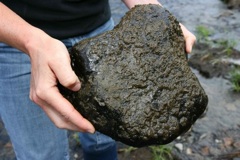
Brown, fuzzy rock snot coats this rock. (Photo: Murray Carpenter)
YOUNG: Algae blooms are usually problems for warm waters laden with excess nutrients. But they’re now popping up in waters considered icons of environmental health—cold, clear, trout and salmon streams.
The alga didymo is spreading quickly, -- it’s better known by its nickname — rock snot. From New Hampshire, Murray Carpenter reports.
CARPENTER: If the name rock snot is not bad enough, consider its appearance. It’s often described as looking like a sewage spill with wet toilet paper streaming in the water. And, strangely, it prefers clean, cold rivers like this one, flowing between New Hampshire and Vermont.
SMAGULA: We’re looking at the Connecticut River right now, and we are in West Stewartstown, New Hampshire, and this stretch has had didymo or rock snot in it for roughly two years now.
CARPENTER: Amy Smagula, a biologist with the New Hampshire Department of Environmental Services, walks to the river to pick up samples of the invader.
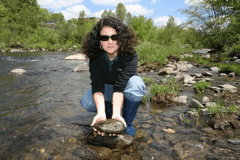
Biologist Amy Smagula shows a rock coated with didymo, aka rock snot, in the Connecticut River in New Hampshire. (Photo: Murray Carpenter)
[SOUNDS OF WALKING IN GRASS]
SMAGULA: If you look across the bottom, the bottom looks a little fuzzier than it normally does. I don’t see the clean rocks that I would expect to see in the Connecticut River. Instead I’m looking at that brown, fuzzy, rock snot growth on top of the rocks.
CARPENTER: Smagula says the blooms are cyclical in some places, and high flows can scour rock snot away. But sometimes it forms thick mats on the riverbed, altering the river’s biological communities. And she says rock snot looks different than most algae.
SMAGULA: The little rock that I’m holding here, I’ve collected out of the river. And in fact, it is green and slimy. And that’s showing you an example of a common algae, a green filamentous algae. The other rock here is also coated with algae but it’s a little different. It’s brownish, and it’s stuck to the rock and it doesn’t feel slimy at all, and that is what rock snot is.
CARPENTER: While it’s native to the northernmost reaches of North America, Europe and Asia, didymo has expanded its range in the last decade, first becoming a nuisance in the western U.S. and Canada, then moving east. Invasive species typically spread like wildfire when they reach a new continent, as rock snot has in New Zealand. But in North America, biologists are wondering why didymo is taking off now after living quietly in the north for at least a century.

Brown, fuzzy rock snot coats this rock. (Photo: Murray Carpenter)
KIRKWOOD: That’s the million-dollar question.
CARPENTER: Andrea Kirkwood, a professor at the University of Ontario Institute of Technology, says didymo is more puzzling than most invaders. She says it may have evolved into a form better adapted to waters that are warmer than those in its native range.
KIRKWOOD: It may be impossible to know for sure, because we don’t have specimens from over 100 years ago, to know for sure if it has changed. But we certainly know that it is behaving much more aggressively now in North America than it did in previous decades.
CARPENTER: Kirkwood says modern environmental conditions could also play a role in rock snot’s recent spread.
KIRKWOOD: We know that it does very well below dam spillways. So when we change a river’s flow, and control flow, we are actually creating ideal habitat, an ideal environment for didymo.
CARPENTER: When rock snot is in full bloom, Kirkwood says it can cover the riverbed like shag carpeting, smothering larval insects like caddisflies, mayflies and stoneflies that are food for trout.
KIRKWOOD: The food that they eat like to hang out, use the rocks as refugia, places to hang out and live in these river systems, so when you have shag carpeting, the didymo bloom, just covering the riverbed, it’s completely changing the habitat structure.

A sign warns fishermen to help stop the spread of rock snot. (Photo: Murray Carpenter)
CARPENTER: Biologists say fish may be able to shift their diets to the midges and worms that are more abundant in areas of didymo blooms, and are trying to understand how rock snot might affect fish and their spawning habitat.
[WATER SOUNDS]
CARPENTER: Nobody knows how rock snot got here to the Connecticut River, but biologists suspect it hitched a ride on an angler. Didymo is a diatom, and its tiny cells can stay viable for weeks on the felt soles of wet waders. It’s already shown up in other eastern trout waters—like Vermont’s Mad River, New York’s Batten Kill, and Maryland’s Gunpowder River.
Joe Norton coordinates habitat restoration on this stretch of the Connecticut River for Trout Unlimited. He says it’s possible to slow didymo’s spread.
NORTON: Not only fishermen, but all river users just need to get in this mindset of cleaning and disinfecting their equipment after they are done.
CARPENTER: River users can disinfect their gear by scrubbing it with hot, soapy water, or spraying it with a bleach solution or the herbicide diquat. When leaving the river, Norton pumps up his spray bottle…
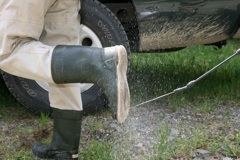
Cleaning boots can help control the spread of rock snot. (Photo: Murray Carpenter)
[PUMPING SOUNDS]
CARPENTER: … and sprays down his waders.
[SPRAYING SOUNDS]
CARPENTER: But biologist, Amy Smagula, says something that makes controlling its spread difficult is that before it takes over a stream, rock snot may be lurking inconspicuously in the water.
SMAGULA: And that’s the scariest part of it is, people don’t know it’s there, and they could easily transport it from river to river. So it’s sort of a silent invader.
CARPENTER: And the silent invasion is continuing in the eastern U.S. In recent months, scientists have confirmed new infestations in two more trout streams: New York’s Esopus Creek and West Virginia’s Seneca Creek.
For Living on Earth, I’m Murray Carpenter, on the Connecticut River in northern New Hampshire.
Related links:
- N.H. Department of Environmental Services on Didymo
- Trout Unlimited on Didymo
[MUSIC: The Orb “A Beautiful Day” from The Dream (Six Degrees 2009)]
Down the Hatch
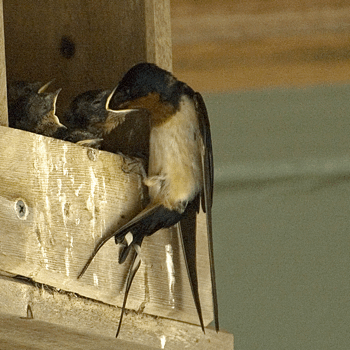
((c) Salt Marsh Diary)
YOUNG: Barn Swallows are wonderfully acrobatic fliers. They have to be to capture enough insects to feed fast-growing nestlings. Mark Seth Lender watched a pair of the small birds take on the huge task.
LENDER: Beneath the sheltering overhang, barn swallows tend their young. Both parents share the work though it is more than work. It is obsession. From first light in widening circles they head out in search of food. The effort is continuous. They sweep and glide in giddy arcs made more magnificent by contrast to their tiny size, sharp blue wing and rounded umber chest flashing by. The skill, taking insects on the fly, is a combination of what can be taught…and what took ten million years to learn.
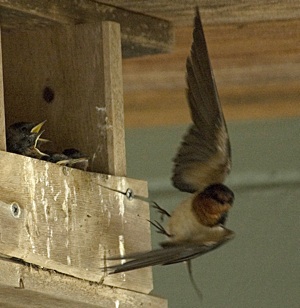
((c) Salt Marsh Diary)
Every sortie begins and ends at the nest. A dull construction made of spittle and mud it clings to the place where it was built as stuck as glue. Inside, the baby birds, barely feathered, wait noiselessly - until a parent appears. Then, cacophony. The chorus of their little voices is like the grating of sand on glass.
So, it’s one to the brood and, two down the hatch and, three off again and even then that gob is never full.
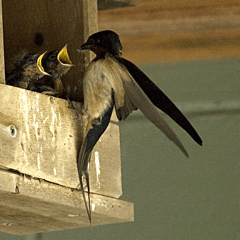
((c) Salt Marsh Diary)
When the parents leave the babes jockey for position. This particular pair of swallows have a tendency to feed their offspring from the same direction, right to left, moving along that always hungry line to each in turn. Which only encourages the strongest and most audacious to switch on subsequent feedings from first place, to second, then third and finally fourth for all the extras he or she can glom. The parents are fooled only some of the time but there is always one a little larger than the others. If politeness counts it is not here.
Meanwhile the ones not fed righteously bellow, each louder than their fellows. And it goes like this all day and it does not stop till dark for even in twilight, when a miniscule prey is that much more invisible, still the parents strive to feed those toothless sharks they bore, who’s only word is more!

((c) Salt Marsh Diary)
Swallows if they dream must dream of gaping mouths. Though they bear their burden in silence I think that they would comment if they could, they just don’t have the time. Such is nature’s trick: parents spend the coin of their lives that progeny will survive.
YOUNG: Mark Seth Lender writes a syndicated column called “Salt Marsh Diary.” To see some of his photographs, go to loe.org.
[MUSIC: Leos Janacek “On The Overgrown Path: They Chattered Like Swallows” from Leos Janacek: The Complete Piano Works (ArcoDiva /The Orchard)]
YOUNG: Living on Earth is produced by the World Media Foundation. Our crew includes: Bobby Bascomb, Eileen Bolinsky, Bruce Gellerman, Ingrid Lobet, Helen Palmer, Jessica Ilyse Smith, Ike Sriskandarajah, and Mitra Taj, with help from Sarah Calkins, Marilyn Govoni, and Sammy Souza. Our interns are Annie Glausser and Lisa Song. Jeff Turton is our technical director. Alison Lirish Dean composed our themes. Our executive producer is Steve Curwood. You can find us anytime at loe.org.
I’m Jeff Young. Thanks for listening.
Living on Earth wants to hear from you!
Living on Earth
62 Calef Highway, Suite 212
Lee, NH 03861
Telephone: 617-287-4121
E-mail: comments@loe.org
Newsletter [Click here]
Donate to Living on Earth!
Living on Earth is an independent media program and relies entirely on contributions from listeners and institutions supporting public service. Please donate now to preserve an independent environmental voice.
NewsletterLiving on Earth offers a weekly delivery of the show's rundown to your mailbox. Sign up for our newsletter today!
 Sailors For The Sea: Be the change you want to sea.
Sailors For The Sea: Be the change you want to sea.
 The Grantham Foundation for the Protection of the Environment: Committed to protecting and improving the health of the global environment.
The Grantham Foundation for the Protection of the Environment: Committed to protecting and improving the health of the global environment.
 Contribute to Living on Earth and receive, as our gift to you, an archival print of one of Mark Seth Lender's extraordinary wildlife photographs. Follow the link to see Mark's current collection of photographs.
Contribute to Living on Earth and receive, as our gift to you, an archival print of one of Mark Seth Lender's extraordinary wildlife photographs. Follow the link to see Mark's current collection of photographs.
 Buy a signed copy of Mark Seth Lender's book Smeagull the Seagull & support Living on Earth
Buy a signed copy of Mark Seth Lender's book Smeagull the Seagull & support Living on Earth

